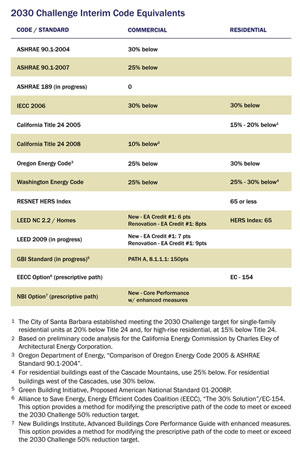Architect Edward Mazria’s Architecture 2030 seeks to convert the building sector from the worst offender of greenhouse gas emissions to an active supporter of global-warming solutions. In an effort to achieve this goal, the non-profit, research organization recently released “Meeting the 2030 Challenge Through Building Codes,” a guide for local governments, states, and industry leaders to significantly reduce greenhouse-gas emissions.
The paper shows how buildings can decrease consumption in the swiftest and most efficient way. An ambitious plan for all new buildings, developments and major renovations, the 2030 Challenge plans to decrease consumption by 50 percent by the designated deadline of 2010 and become carbon neutral by 2030. Many different organizations have adopted the Challenge including the US Conference of Mayors, the American Institute of Architects, and the US Green Building Council. Supporters say that the Challenge is aggressive enough to meet the demanding need for change, while still remaining possible—both financially and technically.
The paper seeks to expedite the first stage using existing energy standards. According to Mazria, executive director of Architecture 2030, “Meeting reduction targets through existing codes is the critical ‘missing piece’ to getting major reductions underway immediately.” Architecture 2030 holds that a single chart is the key to cracking building energy codes to help meet the dramatic 50 percent reduction of emissions. The organization has developed “code equivalents,” which are additional reductions that can be easily incorporated into existing standard requirements. The paper will help local and state governments use original codes, standards, or systems as baselines.
Kent Peterson, the immediate past president of the American Society of Heating, Refrigerator and Air Conditioning Engineers (ASHRAE), thinks the guide is realistic and doable: “I believe that the code based approach is more effective than any other way. Most architects have struggled with how to meet the targets of the 2030 challenge and it’s a great step forward.”
The table lists fourteen codes and standards in the first column followed by the necessary code equivalents for either commercial or residential buildings. “The 2030 Challenge code equivalents listed in Table A provide a simple, practicable solution using existing building energy codes and rating systems,” the paper explains. Besides the obvious improvements in energy efficiency, other benefits of the Challenge are that it is cost effective, it creates new jobs and it can be implemented quickly and successfully.
The paper is an “aspirational guide” according to Harvey Sachs, senior fellow at the American Council for an Energy Efficient Economy. “But the devil’s in the details—it’s not just a matter of writing the plan, but how do you design it and the really tricky issue is how you measure performance,” Sachs said. “It’s going to require a constant level of cooperation and coordination among designers, contractors, and clients to achieve such goals.”







Post a comment to this article
Report Abusive Comment